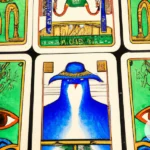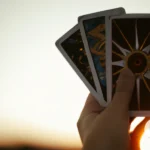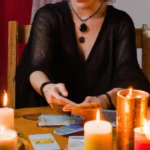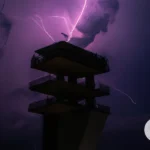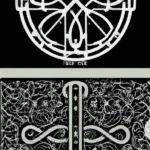As we delve into the mystical world of Tarot, it’s impossible to ignore the significance of the colors in the images. The primary and secondary hues present in each card don’t just exist for aesthetic purposes – they have a deeper meaning that can greatly influence the interpretation of a reading. The colors can evoke emotions, represent themes, and provide insight into the querent’s subconscious. In this comprehensive guide, we’ll explore the importance of each color in Tarot images and how they can be interpreted in readings. Get ready to see the world of Tarot in a whole new colorful light.
Primary Colors in Tarot Images
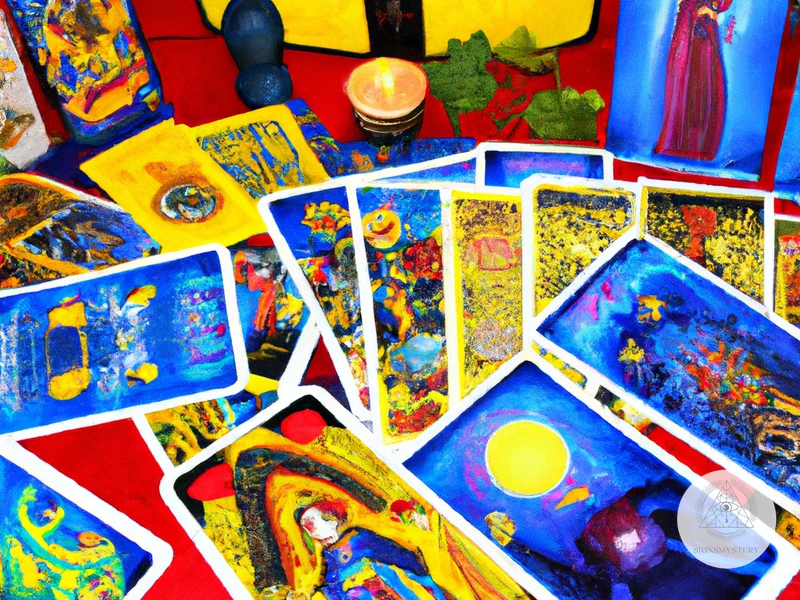
The colors used in Tarot images are not chosen by chance. Each color holds symbolic significance and can convey powerful meanings during a reading. In Tarot, colors are divided into primary and secondary categories. The primary colors, namely red, blue, yellow, and green, have specific interpretations that can affect how a Tarot card is interpreted. Understanding the meaning behind the primary colors in Tarot is crucial for anyone interested in delving deeper into the art of divination. By exploring the significance of each color, we can gain insight into the rich symbolism of the Tarot, which can be complemented by exploring concepts like archetypes or the role of astrology in Tarot.
The Significance of Red in Tarot
Red is a powerful and dynamic color that has significant meaning in tarot readings. It is often associated with passion, energy, and vitality. In tarot images, red can appear in a variety of ways, such as on clothing, backgrounds or even in the color of the entire card.
Here are some examples of the significance of red in tarot:
- Love and Relationships: In love and relationship readings, the color red can symbolize fiery passion, deep love, and desires.
- Emotions: Red can represent strong emotions such as anger, excitement, and enthusiasm. Sometimes, it may suggest aggression or frustration.
- The Magician tarot card: One of the most notable examples of the use of red in tarot is The Magician, who usually wears a red cloak to reflect his power, energy, and action-oriented attitude.
- The Devil tarot card: In contrast to The Magician, The Devil card often features the color red in a more ominous manner to signify temptation, danger, or even addiction.
- The Root Chakra: Red is the color of the Root Chakra, which signifies our connection with the physical world and our basic needs for survival, stability, and security.
It is important to remember that the meaning of the color red in tarot readings may vary based on the context, symbolism, and personal interpretation. A professional tarot reader may use their intuition and knowledge of various divination systems, such as numerology or astrology, to provide a comprehensive and accurate interpretation.
If you are interested in delving deeper into the symbolism and archetypes in tarot readings, you may want to check out resources on major arcana, minor arcana suits, archetypes in tarot cards, and how tarot can relate to Jungian psychology or astrology.
The Meaning of Blue in Tarot Readings
Blue is a color that represents spirituality, inspiration, and mental clarity. When it comes to tarot readings, the color blue often carries an important message. Here are some meanings associated with the color blue in tarot:
- Wisdom: Blue is often associated with wisdom, knowledge, and intellectual pursuits. In tarot readings, the color blue can indicate that the querent is seeking knowledge or wisdom in a particular situation.
- Spirituality: Blue is also associated with spiritual awareness and intuition. When this color appears in a tarot reading, it can indicate that the querent is on a spiritual path or seeking enlightenment.
- Communication: Blue is a color that is often associated with communication and self-expression. In tarot readings, the color blue can indicate that the querent needs to communicate more effectively, express themselves more clearly, or listen more closely to others.
- Peace: Blue is a calming color that often represents peace and tranquility. When this color appears in a tarot reading, it can indicate that the querent needs to find inner peace or that there is a peaceful resolution to a situation.
It is important to note that the meaning of blue in tarot can be influenced by the context of the reading and the other cards in the spread. For example, if the blue card is paired with a card representing sadness or grief, the color blue may represent these emotions as well.
Blue is a color that carries significant meaning in tarot readings. Whether it represents wisdom, spirituality, communication, or peace, the color blue can offer important insights into the querent’s current situation. To learn more about interpreting tarot cards, visit our Numeroscope Tarot Interpretations page.
The Symbolism of Yellow in Tarot Images
Yellow is a vibrant and energetic color that is often associated with joy, happiness, and optimism. In tarot readings, yellow can symbolize a range of different meanings depending on the specific card and the other colors present in the image. Here are some common interpretations of yellow in tarot:
| Symbolism of Yellow | Interpretation in Tarot |
|---|---|
| Sunlight, warmth | Yellow can represent the warmth and energy of the sun, suggesting a time of growth and abundance. |
| Intellect, communication | In some tarot cards, yellow is a symbol of the intellect, indicating a need for clear communication and mental agility in order to succeed. |
| Cowardice, caution | In certain tarot spreads, yellow can suggest a need for caution or fear, indicating that the querent may be hesitant or uncertain about taking action. |
| Positivity, happiness | Yellow is generally associated with positivity and happiness, and may be seen as a sign of good luck or success in tarot readings. |
Depending on the context of the tarot reading and the other colors present in the image, yellow may take on additional or slightly different meanings beyond those listed here. It’s important to consider the overall symbolism and energy of the card in order to interpret yellow fully and accurately.
The Influence of Green in Tarot Readings
Green is an important color in tarot, symbolizing growth, fertility, and abundance. It is also associated with the heart chakra, representing balance and harmony in relationships. In tarot, the color green appears in a variety of ways, from lush landscapes to the clothing worn by characters in the cards. Here are some of the ways green influences tarot readings:
| In the World card: | The greenery in the foreground of the World card represents the abundance and growth that can come from completion of a journey or task. This card encourages us to embrace change and new beginnings, knowing that we have the resources we need to flourish. |
| In the Empress card: | The Empress, often depicted as a pregnant woman, is surrounded by lush greens, representing fertility and growth. This card is associated with nurturing, creativity, and abundance. |
| In the Seven of Pentacles: | The Seven of Pentacles shows a farmer assessing the growth of his crops. The green leaves in the image represent the progress and potential for growth. The card encourages us to take stock of the progress we have made and to stay committed to our goals, even if they take time to fully come to fruition. |
| In combination with other colors: | When combined with other colors, green takes on new meanings. For example, green and red together can represent the balance between passion and practicality. Green and yellow can represent the balance between growth and caution. |
Remember that in tarot, the interpretation of the colors can vary depending on the individual reader and the context of the reading. However, understanding the basic symbolism of each color can add depth and nuance to your tarot practice.
Secondary Colors in Tarot Images
As we delve deeper into the world of colors in tarot, we come across the secondary colors that hold their own significance and bring their unique energy to the readings. These colors are a blend of the primary colors and represent a fusion of their energies, resulting in new interpretations and meanings. Each of the secondary colors has a story to tell in tarot images, and their inclusion in a reading can provide valuable insights into the querent’s life. Let’s explore the hidden messages and symbolism in the secondary colors of tarot.
Purple in Tarot Readings
Purple in Tarot readings is a color that can indicate spirituality, intuition, and royalty. Here are some key points to keep in mind when interpreting the color purple in Tarot:
- Spirituality: Purple is a color that is traditionally associated with spirituality and higher consciousness. When purple appears in a Tarot reading, it can indicate that the seeker is on a spiritual path, seeking higher knowledge or guidance from a higher power.
- Intuition: In addition to its spiritual connotations, purple is also associated with psychic abilities and intuition. When purple appears in a Tarot reading, it can indicate that the seeker is tapping into their intuition or that they should pay attention to their inner voice.
- Royalty: Purple has long been associated with royalty and nobility, as it was a difficult color to produce and therefore was reserved for monarchs and other noble figures in ancient times. In a Tarot reading, the color purple can indicate that the seeker holds themselves in high regard or that they are deserving of respect and honor.
It’s important to remember that the meanings of colors can be influenced by other factors in a Tarot reading, such as the position of the card, the surrounding cards, and the individual symbolism of the Tarot deck being used. As with all Tarot interpretations, the meaning of purple in a reading is open to interpretation and can vary depending on the seeker’s personal circumstances and the context of the reading. It’s up to the reader to use their intuition and experience to determine the most accurate interpretation of the color purple in each individual reading.
The Importance of Orange in Tarot Images
Orange is not one of the primary colors in tarot, but it still holds significant symbolism in tarot images. In tarot, orange represents energy, passion, and enthusiasm. It is associated with the sacral chakra and is said to represent the blending of red and yellow energies.
Here is a table outlining the symbolism of orange in tarot:
| Symbolism | Meaning |
|---|---|
| Creativity | Orange is often associated with creativity, particularly in art and design. It is said to inspire new ideas and creative projects. |
| Passion | Orange is also associated with passion and desire. It can represent the intensity of a romantic relationship or the drive to achieve goals and dreams. |
| Courage | In some tarot decks, orange is associated with courage and taking risks. It can represent the need to step outside of one’s comfort zone in order to achieve success. |
| Socializing | Orange can also be associated with socializing and networking. It is said to promote communication and interpersonal connections. |
| Vitality | Finally, orange is associated with vitality and energy. It can represent the need to take action and move forward in life. |
When interpreting tarot cards that prominently feature the color orange, it is important to consider these various meanings and how they might apply to the specific card or spread. For example, an orange background on a card may speak to the need for creativity and inspiration in a given situation, while an orange object within the card may represent a particular passion or desire.
Orange may not be as commonly seen in tarot as other colors, but it still holds significant symbolism and meaning that can inform a tarot reading.
The Role of Pink in Tarot Readings
Pink, as a color in tarot readings, carries various meanings and symbolisms. It is often associated with love, romance, and affection. Pink is a blend of the passionate and aggressive energy of red, and the calm and soothing energy of white. This color can represent different aspects of love, depending on the context of the tarot reading.
One interpretation of the pink color in tarot readings is that it represents infatuation, desire, and attraction. The color can indicate a new romantic relationship or a crush. The strong emotion of attraction can be both passionate and reckless. The Knight of Cups card, for example, often features a pink color in the background, symbolizing his romantic and dreamy nature in pursuing his desires.
On the other hand, pink can also convey the qualities of tenderness, compassion, and nurturing. In tarot readings, pink can represent the love and care that one has for their family, friends, or even strangers. Pink can be a reminder to show kindness and empathy towards others. The Empress card, which may have a pink hue in it, represents motherly love, nurturing, and compassion.
Another significance of the pink color in tarot readings is its connection to the heart chakra, which is the center of love, forgiveness, and compassion. The heart chakra is associated with healing emotional wounds, letting go of grudges, and opening up to new relationships. Pink can indicate a need for emotional healing, forgiveness, or self-love. The Lovers card, which may be accompanied by pink colors, represents the choice between love and temptation, and the importance of balancing the heart and mind.
Pink is a versatile color in tarot readings, representing both the passionate and tender aspects of love. It can indicate a new romance, remind us to show kindness, or connect us to our heart center. Understanding the significance of colors in tarot images can enhance your tarot reading experience and provide deeper insight into the messages of the cards.
| Interpretation | Example Card |
|---|---|
| Infatuation, desire, and attraction | The Knight of Cups |
| Tenderness, compassion, and nurturing | The Empress |
| Connection to heart chakra | The Lovers |
The Use of Black and White in Tarot Images
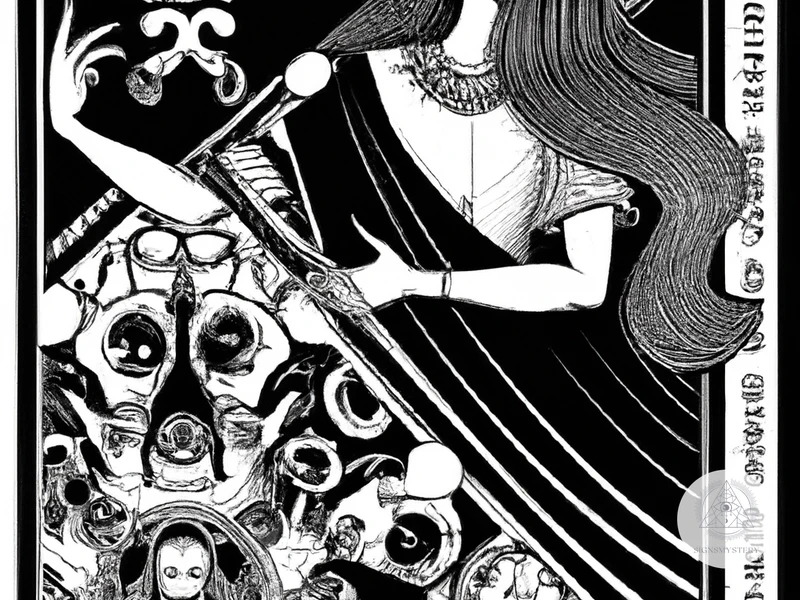
The absence of color can sometimes speak volumes in tarot readings. Black and white, as a dichotomy, represents a spectrum of meanings and elements involved in a reading. From the deepest depths of the unknown and hidden, to the purity of enlightenment, black and white can be powerful symbols in tarot. In this section of the article, we’ll investigate the meanings and interpretations that can be ascribed to black and white in tarot images.
The Meaning of Black in Tarot Readings
Black is an essential color in Tarot readings, representing endings, transformations, and sometimes, death. It is a color that evokes a sense of mystery and the unknown. Here are some significant meanings of black in Tarot images:
- Endings and Transformations: In Tarot, black is associated with the death card. This card signifies endings and the start of transformation. It invites the person into a space of reflection and contemplation, where they can release old patterns and habits to make way for something new.
- The Unknown: Black also represents the unknown and the mysterious. When it appears in Tarot readings, it is a call for theperson to dive deeper into their subconscious; to confront their fears, and understand the aspects of themselves, they may be afraid to confront. It can be a powerful reminder that even in darkness, there is light and hope.
Subscribe to Our Newsletter
Sign up to receive the latest news and updates.
- The Shadow Side: Black is also associated with one’s shadow side, representing the fears, doubts, and negative patterns that may hold them back. The black in Tarot is a reminder that while it is essential to face one’s shadow side, it is equally important not to get lost in it. Instead, it is an invitation to walk through the darkness, facing fears, and coming out on the other side stronger and more self-aware.
When interpreting the color black in Tarot readings, it is crucial to consider the cards’ context, as well as the sensitivities and intuition of the reader. While it does represent endings, it can also indicate new beginnings, transformation, and growth. Ultimately, the meaning of black in Tarot readings depends on the context in which it appears and the reader’s interpretation.
The Significance of White in Tarot Images
White is a color that is often associated with purity and innocence. In the context of tarot, white can have a variety of significant meanings. Below are some of the possible interpretations of white in tarot images:
- Clarity: White can represent clarity and purity of thought, indicating a clear understanding of a situation or a way forward.
- Beginnings: In tarot, white can symbolize new beginnings, indicating the start of a journey or a new phase in one’s life.
- Transformation: White can represent transformation, suggesting that a person is going through a period of change or personal growth.
- Enlightenment: Like a blank canvas, white can symbolize the potential for enlightenment and spiritual growth.
- Rebirth: White can represent rebirth, indicating the end of one phase of life and the beginning of another, like the phoenix rising from the ashes.
Of course, the meanings of white in tarot can vary depending on the context of the card and the individual reader’s interpretation. As with any tarot reading, it’s important to consider the card’s imagery as a whole and the surrounding cards to get a complete picture of the message being conveyed.
How to Interpret Colors in Tarot Readings
As colors play a significant role in tarot readings, it is important to understand their different interpretations and meanings. The understanding of color is particularly relevant when interpreting tarot cards as it can help provide deeper insights into the complexities of the reading. In this section, we will explore various ways to interpret colors in tarot readings and learn how to integrate these interpretations into our readings. Let us delve into the intricacies of color symbolism in tarot images.
The Role of Color in Card Combinations and Spreads
When it comes to interpreting tarot card combinations and spreads, the role of color cannot be ignored. Color can add depth and nuance to a reading, and can help guide the interpretation of the cards. Here’s how different colors may affect the meaning of a tarot reading:
| Color | Meaning |
|---|---|
| Red | Represents passion, emotion, and intensity. When paired with cards such as The Devil or The Tower, it may suggest intense emotions and a need to regain control. |
| Blue | Represents intuition, healing, and clarity. When paired with cards such as The High Priestess or The Star, it may suggest the need to trust intuition and find peace in difficult situations. |
| Yellow | Represents intellect, self-confidence, and joy. When paired with cards such as The Magician or The Sun, it may suggest a need for creative thinking, optimism, and self-assurance. |
| Green | Represents growth, abundance, and harmony. When paired with cards such as The Empress or The World, it may suggest opportunities for growth and abundance in all areas of life. |
| Purple | Represents spirituality, wisdom, and transformation. When paired with cards such as The Hierophant or Judgment, it may suggest a need for reflection and spiritual growth. |
| Orange | Represents creativity, passion, and enthusiasm. When paired with cards such as The Fool or The Chariot, it may suggest the need to embrace opportunities and take risks. |
| Pink | Represents love, compassion, and nurturing. When paired with cards such as The Empress or The Lovers, it may suggest the importance of love and relationships in one’s life. |
| Black | Represents mystery, unknown, and fear. When paired with cards such as Death or The Hanged Man, it may suggest a need to confront and overcome fear. |
| White | Represents purity, clarity, and new beginnings. When paired with cards such as The Fool or The World, it may suggest a fresh start and new opportunities. |
Of course, the meanings of colors may vary depending on the specific cards in a tarot reading and the interpretation of the reader. However, taking into consideration the symbolism and associations commonly attributed to colors can help provide a more nuanced interpretation of the cards.
The Integration of Color in Interpretations
The integration of color is an essential component in interpreting tarot cards. Each color has a unique vibration that influences the meaning of a card. By incorporating color analysis into tarot readings, one can gain a deeper understanding and insight into the symbolism portrayed by each card. Below is a table showcasing examples of how color can affect card interpretation:
| Color | Card | Interpretation |
|---|---|---|
| Red | The Chariot | Red represents passion and action, which is fitting for The Chariot. This card is all about moving forward with determination and drive. |
| Blue | The High Priestess | Blue embodies intuition and spirituality, which aligns perfectly with The High Priestess. This card represents inner knowing and the power of intuition. |
| Yellow | The Sun | Yellow symbolizes joy and happiness, which reflects the energy of The Sun. This card represents positivity, warmth, and vitality. |
| Green | The Empress | Green represents growth and abundance, which embodies the energy of The Empress. This card symbolizes fertility, creativity, and nurturing. |
| Purple | The Hierophant | Purple signifies wisdom and spirituality, making it an ideal match for The Hierophant. This card represents divine guidance and spiritual teachings. |
| Orange | The Fool | Orange represents enthusiasm and new beginnings, which aligns well with The Fool. This card symbolizes the start of a journey and the excitement of the unknown. |
| Pink | The Lovers | Pink embodies love and romance, which is the essence of The Lovers. This card represents harmony, balance, and relationships. |
| Black | The Tower | Black signifies the unknown and the shadow side, which is important for The Tower. This card represents sudden upheaval and destruction. |
| White | The World | White represents purity and completion, which aligns perfectly with The World. This card symbolizes the end of a cycle and the achievement of a goal. |
As we can see from the examples above, each color plays a significant role in tarot interpretation. By taking note of the colors present in a reading, we can gain a deeper understanding of the messages that the cards are trying to convey. By integrating color analysis into tarot readings, one can unlock new insights and truths that were previously hidden.
Conclusion
In conclusion, it is clear that the significance of colors in tarot images is multifaceted and complex. Each hue holds a unique meaning and symbolizes various emotions, elements, and states of being. From the fiery passion of red to the peacefulness of blue, colors play a vital role in tarot readings, providing insight and guidance to the reader and the querent.
It is essential to remember that while colors hold specific meanings, their interpretations may also vary depending on the context of a reading. The integration of color into card combinations and the larger spread is crucial to understanding the overarching message of a reading.
When interpreting colors in tarot readings, it is crucial to study their meanings and symbolism in combination with the card’s traditional interpretation. A thoughtful and comprehensive approach to color analysis will allow for a more profound and nuanced understanding of the messages and insights provided by the tarot.
Overall, the use of color in tarot readings is not only beautiful and visually stunning but has significant implications for the reader and the querent. An understanding of color symbolism and interpretation can lead to more insightful and effective readings and a deeper connection with the ancient and mystical practice of tarot.
Frequently Asked Questions
What is the significance of color in tarot reading?
The colors in tarot images have symbolic meanings that help readers interpret the messages and energies of each card.
What are the primary colors in tarot images?
The primary colors in tarot are red, blue, yellow, and green. These colors are considered the building blocks for all other colors.
What does the color red symbolize in tarot?
Red is associated with passion, energy, power, and strength. It can also represent warnings or danger.
What is the meaning of blue in tarot readings?
Blue is often associated with calmness, communication, and truth. It can also denote spirituality and intuition.
What does yellow represent in tarot images?
Yellow is the color of optimism, positivity, and creativity. It also can symbolize intellect and logic.
What is the significance of green in tarot?
Green is the color of growth, balance, and harmony. It is also associated with abundance and financial prosperity.
What are the secondary colors in tarot images?
The secondary colors in tarot are purple, orange, and pink. These colors are often created from mixing two primary colors together.
What is the meaning of purple in tarot readings?
Purple represents spirituality, mystery, and magic. It can also denote luxury and power.
What is the role of black in tarot images?
Black is often associated with darkness, mystery, and the unknown. It can also represent negative energy or obstacles.
How can colors be integrated into tarot interpretations?
Colors can be incorporated into interpretations by examining how they interact with each other in the image and considering their symbolic meanings in relation to the question or spread being read.






